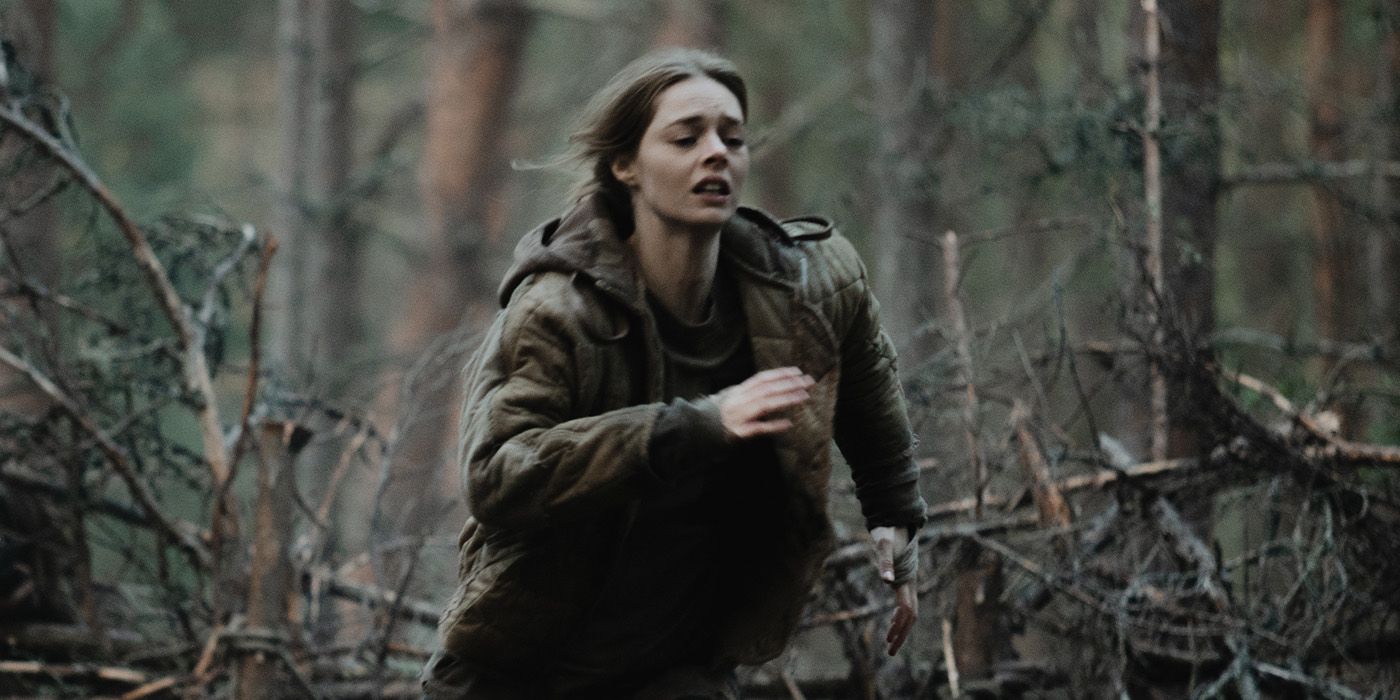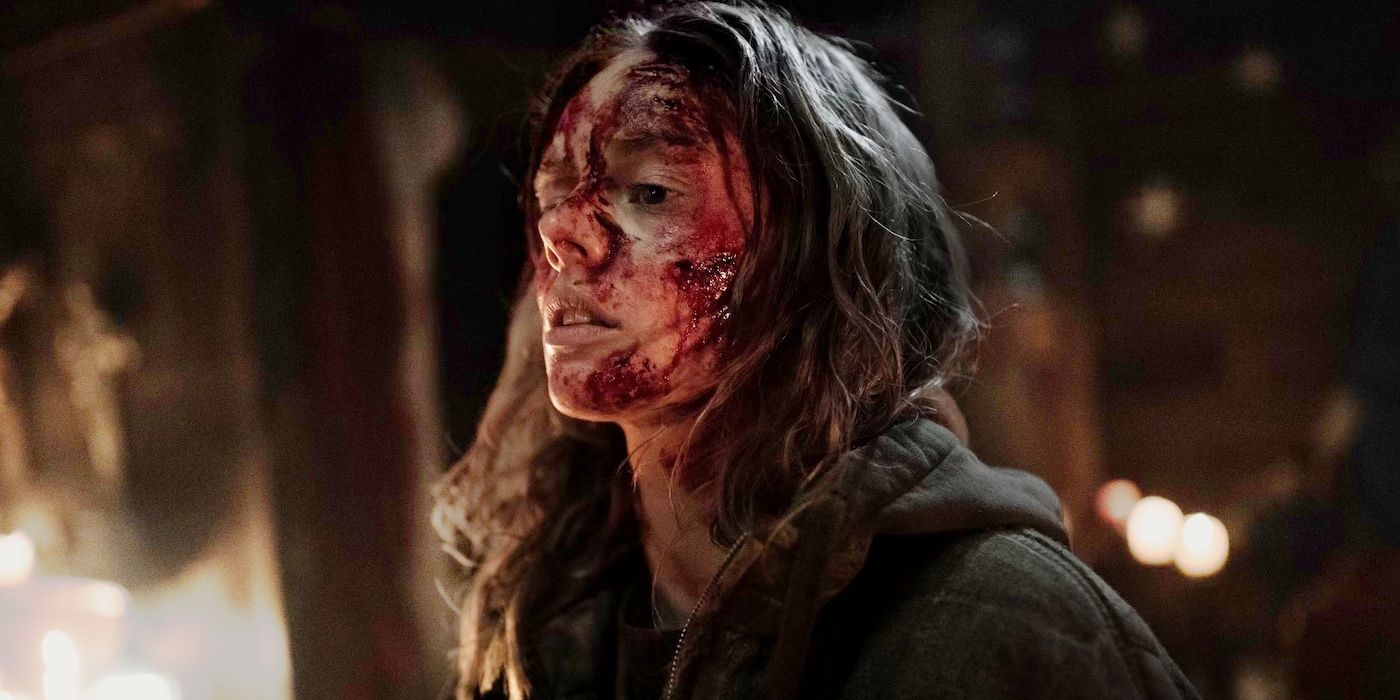[Editor’s note: The following contains major spoilers for Azrael.]
The Big Picture
- The horror film ‘Azrael’ takes place In a world where silence reigns and a woman must fight for survival after escaping captivity.
- Originally planned as a one-shot film, logistical issues led to a change in filming style.
- Lead actress Samara Weaving discusses the challenges of filming in Estonia with night shoots and stunts.
Directed by E.L. Katz and written by Simon Barrett, the real-time indie horror flick Azrael is set in a world in which no one speaks and follows a woman (Samara Weaving) who has escaped imprisonment. Meant to be a sacrifice to the evil in the woods, she is terrified of being recaptured and continues to fight her way to survival.
During this one-on-one interview with Collider, Weaving shared that they were originally going to film it all in one shot, but ultimately had to scrap that idea. She also talked about all the night shoots in Estonia, working out all the stunts and fights, developing an entire relationship with just a kiss, how they needed to use a little movie magic, working with the actors playing the creatures, and just what was going on with that baby.
Samara Weaving Was Excited About the Challenge of Shooting ‘Azrael’ Without Dialogue
Collider: When this came your way, how was it presented to you? What were you told about it? Were you given a script?
SAMARA WEAVING: Yeah, it was a script, and then (director) Evan [Katz] wanted to meet. I read it and it scared me. I was like, “Oh, I haven’t done this. This is crazy.” Having to tell a story without using your words, that’s something that won’t come along very often. I came on pretty quickly, just because I wanted to challenge myself in that way, with all the elements of shooting on location in the middle of nowhere in Estonia, all night shoots, fighting dudes. I was like, “Let’s go.”
How many conversations did you have about the story, what it would be, who the character is, and what got her into this situation? Did you talk everything out ahead of time? Was it an ongoing conversation?
WEAVING: A lot of it was in the script. You got a sense of what the backstory was from that. I added to it for my own preparation. And then, as we were shooting, I was talking to (writer) Simon [Barrett], and he had his idea of what happened before and after. So, it was an accumulation of all those ideas, and then we would just map it out. But it was pretty much all there on the page.
Did it change and evolve in any way, from when they first talked to you about it to what we see now, or did this turn out the way you always thought it would?
WEAVING: The only thing was that originally it was gonna be one shot. And then, they looked into it and went, “That’s so ambitious. We can’t do that. It’s near impossible.” That was the one thing that changed. Everything else was pretty much the same, at least from my point of view.
That would have been wild to do in one shot.
WEAVING: Yeah. I was excited though. I was like, “Let’s go!”
What would you say most prepared you to take this on? Did you have to do any sort of training specific to what was required of you?
WEAVING: Stanimir [Stamatov], the stunt coordinator, definitely helped. The whole thing is just stunts and fighting, and having someone who really understood storytelling through stunts and having different variations of fights, with some that are faster-paced or with scratching and pulling. My favorite one was when I was in the mud with Phong [Giang] and we were crawling around. It was really sluggish and slow, and I was slowly pulling a gun up to his head, and it was all just so heavy. Having him design those sequences was so helpful.
We see you, toward the beginning of this, share a kiss with someone, and that’s really all we have to go on when it comes to their relationship. What was it like to build a relationship like that and figure out how to show all that history in just a moment without the dialogue and without flashbacks? What was that like to explore?
WEAVING: I just had to cross my fingers and hope for the best. Nathan [Stewart-Jarrett] and I would talk about it and we were like, “We have to really try to make the audience care about these people, so that they stay with her for the rest of the movie.” But he was great.
The Mostly Silent ‘Azrael’ Still Needed Some Help From a Little Movie Magic
You’re not just not speaking in this. You’re also really not making a sound. Was it ever challenging to not make noise, especially during some of the more physical moments?
WEAVING: If you have your voice box damaged, all your muscles are still working and trying to do the same thing. It’s just that there’s no noise coming out. So, it was really hard for me to try to look like I’m screaming but not screaming and look like I’m yelling but not yelling. It was a week out, and I was like, “I’m freaking out that I can’t do this.” I was like, “Hey, Evan, do you mind if I just actually scream and yell and shout and make noises, and you just get rid of them in post?” And he was like, “Great. Done.” I was like, “I’m gonna need six months to make this work, and we have two weeks. Let’s do movie magic. How about that?” And then, they did ADR with a woman who has damaged vocal cords.
At what point do you start to lose your mind when you’re doing night shoots?
WEAVING: There was a bit of that. Honestly, my poor assistant did lose her mind. She was gone. Because I was screaming and running and yelling at people all day, I was so calm. I could get all my frustration out, that I hadn’t seen sunlight in three weeks at work, and then go home and sleep like a baby. It was great. But the crew had to stand around in the cold, and it was so cold. We were in little trailers in the middle of nowhere and staying in spooky hotels on the side of the road. Everyone went a bit insane, but it worked, so it was great.
With the scene toward the end where you’re closed into a coffin space, and you’re going in and out of a tunnel and you have this thing chasing you, that then lays over you and is silently screaming in your face while you’re silently screaming back, what was that like to shoot? Was that weird to do?
WEAVING: It was weird. We shot that at the end of the shoot, and I was like, “Every day has been weird, but now everything is normal.” They got mostly dancers to play the burnt people. You’d see them in the morning, having cigarettes and hanging out and drinking their coffee, covered in all these prosthetics. You’d just get to know them and chat. They look scary, but when you know them, it’s like any other scene. It wasn’t too weird. We were like, “Oh, today we’re yelling in each other’s faces? Let’s do it.”
What Exactly Is the Deal With That ‘Azrael’ Baby?
At the end of this, when you’re holding the baby, what were you actually holding?
WEAVING: Oh, they made it. That’s real. That was a practical puppet. It was terrifying. I think that was the very last day of shooting, and I was like, “What is happening?” Someone just came out with this thing and was like, “So, here’s your baby.” And I was going, “Uh, okay.” But it was great. Having to try to imagine that, it’s always so much easier when there’s a physical thing there.
You also have Carolina Caroline with Kyle Gallner. What did you enjoy about working alongside him? What attracted you to that project?
WEAVING: We just wrapped. It was amazing. It’s a departure for both of us. We are from horror genre worlds, and this is nothing like that at all, but I think the horror fans will still love it. He’s just the greatest. It was a dream to work with him. I think it’s gonna be really special.
Azrael is now playing in theaters. Check out the trailer:
Buy tickets


